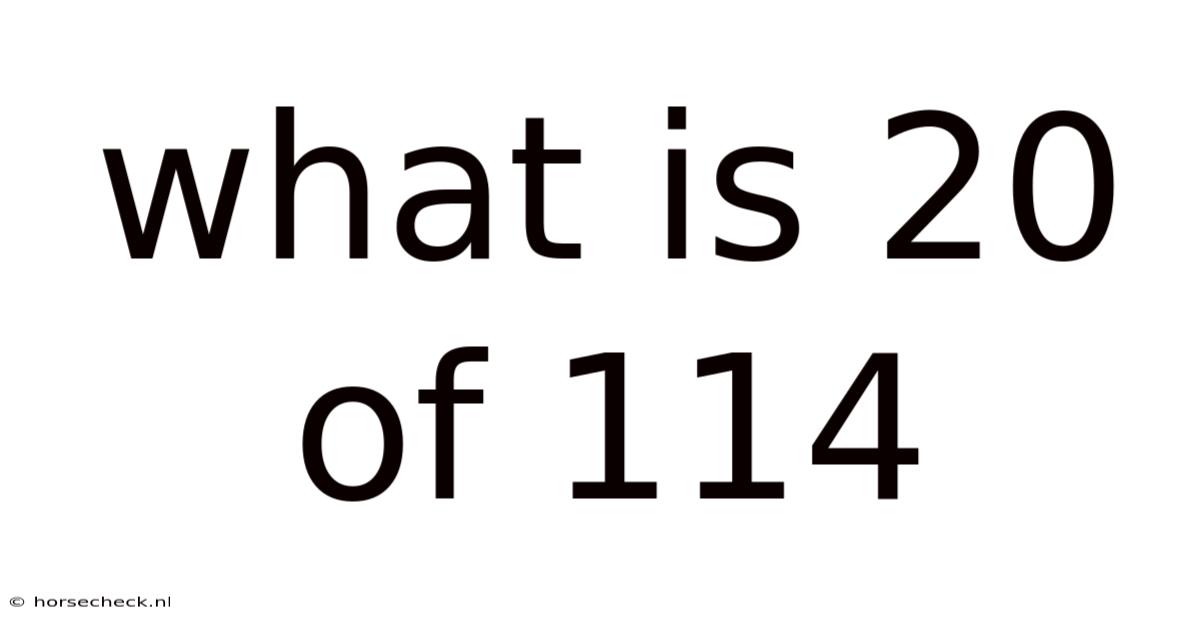What Is 20 Of 114
horsecheck
Sep 25, 2025 · 4 min read

Table of Contents
What is 20 of 114? Unpacking Percentages, Fractions, and Ratios
This article explores the multifaceted question, "What is 20 of 114?" We will delve into different mathematical approaches to understand this relationship, clarifying the concepts of percentages, fractions, and ratios. Understanding these fundamental mathematical tools is crucial for various applications in everyday life, from calculating discounts and sales tax to analyzing data and making informed decisions.
Understanding the Question: Percentages, Fractions, and Ratios
The question, "What is 20 of 114?" implicitly asks us to determine the proportional relationship between 20 and 114. This can be expressed in several ways:
- As a fraction: 20/114 represents the portion of 114 that is 20.
- As a percentage: This shows 20 as a percentage of 114, indicating what proportion 20 represents out of the total 114.
- As a ratio: This compares 20 to 114, highlighting their relative sizes.
We will calculate each of these representations, explaining the process in detail.
1. Calculating the Fraction
To find the fraction representing 20 out of 114, we simply write 20 as the numerator (the top number) and 114 as the denominator (the bottom number):
20/114
This fraction can be simplified by finding the greatest common divisor (GCD) of 20 and 114. The GCD is 2. Dividing both the numerator and the denominator by 2, we get:
10/57
Therefore, 20 out of 114 is equivalent to the simplified fraction 10/57. This means that 20 represents 10 out of every 57 parts of 114.
2. Calculating the Percentage
To express 20 out of 114 as a percentage, we first calculate the fraction, as shown above (20/114 or its simplified form 10/57). Then, we convert the fraction to a decimal by dividing the numerator by the denominator:
10 ÷ 57 ≈ 0.1754
To convert this decimal to a percentage, we multiply by 100:
0.1754 × 100 ≈ 17.54%
Therefore, 20 is approximately 17.54% of 114.
3. Expressing the Relationship as a Ratio
A ratio compares two quantities. In this case, the ratio of 20 to 114 can be written as:
20:114
Similar to the fraction, this ratio can be simplified by dividing both numbers by their GCD (which is 2):
10:57
This simplified ratio indicates that for every 10 units, there are 57 units in the total.
Applications and Real-World Examples
Understanding the relationship between 20 and 114, expressed as a fraction, percentage, or ratio, has numerous practical applications:
- Sales and Discounts: Imagine a store offering a discount. If an item originally costs 114 units of currency, and a 20 unit discount is offered, the discount percentage would be 17.54%, as calculated above.
- Data Analysis: Suppose you are analyzing survey results. If 114 people participated, and 20 selected a particular option, then 17.54% of respondents chose that option.
- Probability: In probability calculations, if there are 114 possible outcomes, and 20 are favorable, the probability of a favorable outcome is 10/57 or approximately 17.54%.
- Proportional Reasoning: Imagine a recipe that calls for 114 grams of flour and 20 grams of sugar. The ratio of sugar to flour is 10:57, enabling you to scale the recipe up or down proportionally.
Further Exploration: Rounding and Precision
In the percentage calculation, we obtained 17.54%. The level of precision required depends on the context. In some situations, rounding to 17.5% or even 18% might be sufficient. However, maintaining more decimal places provides greater accuracy. The choice of rounding depends on the context and the acceptable level of error.
Frequently Asked Questions (FAQ)
Q: Can I use a calculator for these calculations?
A: Absolutely! Calculators are helpful for performing the division required for percentage calculations. However, understanding the underlying concepts of fractions and ratios is still important.
Q: Why is it important to simplify fractions and ratios?
A: Simplifying makes it easier to understand the proportional relationship between the numbers. A simplified fraction or ratio is easier to visualize and compare.
Q: What if the numbers were larger or involved decimals?
A: The same principles apply. You would still calculate the fraction, percentage, and ratio using the same methods. Calculators become increasingly helpful with larger or decimal numbers.
Conclusion: Mastering Proportional Relationships
This exploration of "What is 20 of 114?" has provided a comprehensive understanding of how to express this relationship using fractions, percentages, and ratios. Mastering these fundamental concepts is crucial for various applications in mathematics, science, and everyday life. By understanding how to calculate and interpret these proportional relationships, you can enhance your analytical skills and make informed decisions in a wide range of contexts. Remember that the key is not just obtaining the numerical answer but also understanding the underlying concepts and their significance. Practice with different numbers and scenarios will further solidify your understanding of these valuable mathematical tools.
Latest Posts
Latest Posts
-
What Numbers Go Into 17
Sep 25, 2025
-
Factors Of 3 And 4
Sep 25, 2025
-
What Are Factors For 60
Sep 25, 2025
-
Whats The Decimal For 1 4
Sep 25, 2025
-
62 100 As A Percentage
Sep 25, 2025
Related Post
Thank you for visiting our website which covers about What Is 20 Of 114 . We hope the information provided has been useful to you. Feel free to contact us if you have any questions or need further assistance. See you next time and don't miss to bookmark.